
APPLICATIONS
• Battery banks• Solar installations
GENERAL DESCRIPTION
The ND15A20 superdiode is a low-frequency rectifier performing a function analogous to the standard diode. Compared to a standard diode, the superdiode will conduct current with much reduced forward voltage drop. Typical forward voltage drop at 15A current is around 75mV. The standard Schottky diode rated for the same maximum forward current will feature substantially more power dissipation due to higher voltage drop across the device. Current [A]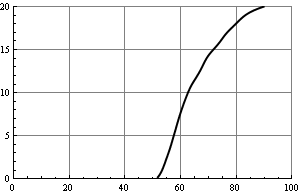 Forward Voltage [mV]
Forward Voltage [mV]The ND15A20 superdiode is designed to operate without a heat-sink. As is the case with all semiconductor devices, forward current flow causes temperature rise of the device beyond the ambient temperature of the environment. The actual maximum sustainable device current is therefore dependent on the ambient temperature. The temperature rise of 50C corresponds to 15A forward current. Nevertheless, the device can sustain an occasional overcurrent exceeding 20A. Temperature [C]
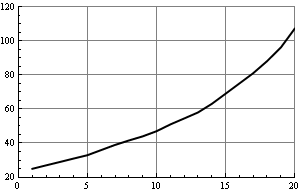 Forward Current [A]
The forward start-up current of ND15A20 is less than 15mA. The
voltage-current characteristic for currents below this value exhibits
hysteresis. Once in superdiode mode (forward conduction with low
voltage drop) the current can be decreased down to single milliamps
before the superdiode mode stops. When not in superdiode mode, the
characteristic is that of the standard Schottky diode.
Current [mA]
Forward Current [A]
The forward start-up current of ND15A20 is less than 15mA. The
voltage-current characteristic for currents below this value exhibits
hysteresis. Once in superdiode mode (forward conduction with low
voltage drop) the current can be decreased down to single milliamps
before the superdiode mode stops. When not in superdiode mode, the
characteristic is that of the standard Schottky diode.
Current [mA]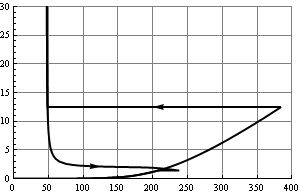 Forward Voltage [mV]
Forward Voltage [mV]The dynamic response of the ND15A20 is fast-on, slow-off. Switching times are somewhat dependent on the overall circuit impedance. The turn-off time when driven with a 20V peak-to-peak function generator square wave with a 50Ohm port is typically less than 5ms. The reverse continuous blocking voltage is at least 20V. Step Response (Voltage) [5V/div]
 Time [5ms/div]
Time [5ms/div]DIMENSIONS
 Units: mil
The ND15A20 is a mini-circuit assembled on the FR-4 printed circuit
board material. It is solder-ready on both sides of the PCB. Five
solder vias at both edges of the board can accommodate current routing
wires. Two large holes allow for terminal connections such as the
standard 3/4 inch mounting posts or banana plugs.
Units: mil
The ND15A20 is a mini-circuit assembled on the FR-4 printed circuit
board material. It is solder-ready on both sides of the PCB. Five
solder vias at both edges of the board can accommodate current routing
wires. Two large holes allow for terminal connections such as the
standard 3/4 inch mounting posts or banana plugs.
FOOTPRINT
 Units: mil
The board is flat with exposed pads on solder side and can be directly
soldered to the main printed circuit board, according to the footprint
provided.
Units: mil
The board is flat with exposed pads on solder side and can be directly
soldered to the main printed circuit board, according to the footprint
provided.
APPLICATIONS
Battery separation: A common method to build a large capacity battery bank is to connect many batteries in parallel. However, if one of the batteries becomes weak or fails, the entire battery bank could be compromised and in need for service. Instead, batteries can be separated from each other with superdiodes, as shown in the figure.
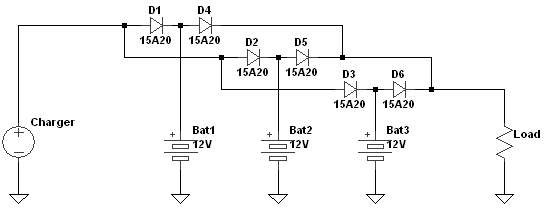 |
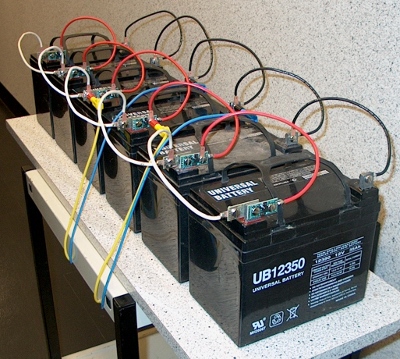

|
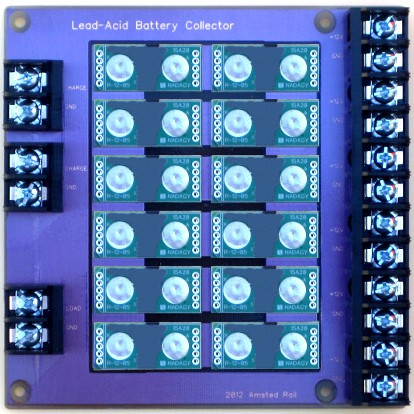 |
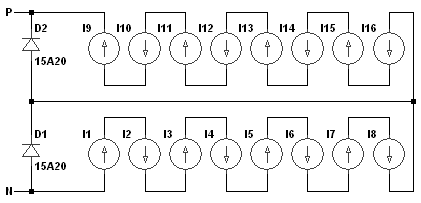 |
